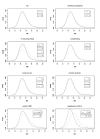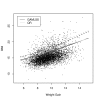Alternative regression models to assess increase in childhood BMI
- PMID: 18778466
- PMCID: PMC2543035
- DOI: 10.1186/1471-2288-8-59
Alternative regression models to assess increase in childhood BMI
Abstract
Background: Body mass index (BMI) data usually have skewed distributions, for which common statistical modeling approaches such as simple linear or logistic regression have limitations.
Methods: Different regression approaches to predict childhood BMI by goodness-of-fit measures and means of interpretation were compared including generalized linear models (GLMs), quantile regression and Generalized Additive Models for Location, Scale and Shape (GAMLSS). We analyzed data of 4967 children participating in the school entry health examination in Bavaria, Germany, from 2001 to 2002. TV watching, meal frequency, breastfeeding, smoking in pregnancy, maternal obesity, parental social class and weight gain in the first 2 years of life were considered as risk factors for obesity.
Results: GAMLSS showed a much better fit regarding the estimation of risk factors effects on transformed and untransformed BMI data than common GLMs with respect to the generalized Akaike information criterion. In comparison with GAMLSS, quantile regression allowed for additional interpretation of prespecified distribution quantiles, such as quantiles referring to overweight or obesity. The variables TV watching, maternal BMI and weight gain in the first 2 years were directly, and meal frequency was inversely significantly associated with body composition in any model type examined. In contrast, smoking in pregnancy was not directly, and breastfeeding and parental social class were not inversely significantly associated with body composition in GLM models, but in GAMLSS and partly in quantile regression models. Risk factor specific BMI percentile curves could be estimated from GAMLSS and quantile regression models.
Conclusion: GAMLSS and quantile regression seem to be more appropriate than common GLMs for risk factor modeling of BMI data.
Figures


Similar articles
-
Breastfeeding and childhood obesity: shift of the entire BMI distribution or only the upper parts?Obesity (Silver Spring). 2008 Dec;16(12):2730-3. doi: 10.1038/oby.2008.432. Epub 2008 Oct 9. Obesity (Silver Spring). 2008. PMID: 18846050
-
Risk factors for childhood obesity: shift of the entire BMI distribution vs. shift of the upper tail only in a cross sectional study.BMC Public Health. 2008 Apr 10;8:115. doi: 10.1186/1471-2458-8-115. BMC Public Health. 2008. PMID: 18402677 Free PMC article.
-
Risk factors for childhood overweight: shift of the mean body mass index and shift of the upper percentiles: results from a cross-sectional study.Int J Obes (Lond). 2010 Apr;34(4):642-8. doi: 10.1038/ijo.2009.301. Epub 2010 Jan 19. Int J Obes (Lond). 2010. PMID: 20084072
-
[Simple obesity in children. A study on the role of nutritional factors].Med Wieku Rozwoj. 2006 Jan-Mar;10(1):3-191. Med Wieku Rozwoj. 2006. PMID: 16733288 Review. Polish.
-
Offspring body size and metabolic profile - effects of lifestyle intervention in obese pregnant women.Dan Med J. 2014 Jul;61(7):B4893. Dan Med J. 2014. PMID: 25123127 Review.
Cited by
-
Risk factors relate to the variability of health outcomes as well as the mean: A GAMLSS tutorial.Elife. 2022 Jan 5;11:e72357. doi: 10.7554/eLife.72357. Elife. 2022. PMID: 34985412 Free PMC article.
-
Association between Infant Feeding and Early Postpartum Infant Body Composition: A Pilot Prospective Study.Int J Pediatr. 2009;2009:648091. doi: 10.1155/2009/648091. Epub 2009 Mar 12. Int J Pediatr. 2009. PMID: 20041019 Free PMC article.
-
Evolving forecasting classifications and applications in health forecasting.Int J Gen Med. 2012;5:381-9. doi: 10.2147/IJGM.S31079. Epub 2012 May 8. Int J Gen Med. 2012. PMID: 22615533 Free PMC article.
-
Gestational weight gain and body mass index in children: results from three german cohort studies.PLoS One. 2012;7(3):e33205. doi: 10.1371/journal.pone.0033205. Epub 2012 Mar 22. PLoS One. 2012. PMID: 22457745 Free PMC article.
-
Prediction intervals for future BMI values of individual children: a non-parametric approach by quantile boosting.BMC Med Res Methodol. 2012 Jan 25;12:6. doi: 10.1186/1471-2288-12-6. BMC Med Res Methodol. 2012. PMID: 22276940 Free PMC article.
References
-
- Toschke AM, Lüdde R, Eisele R, von Kries R. The obesity epidemic in young men is not confined to low social classes – a time series of 18-year-old German men at medical examination for military service with different educational attainment. International Journal of Obesity. 2005;29:875–877. doi: 10.1038/sj.ijo.0802989. - DOI - PubMed
Publication types
MeSH terms
LinkOut - more resources
Full Text Sources
Medical

